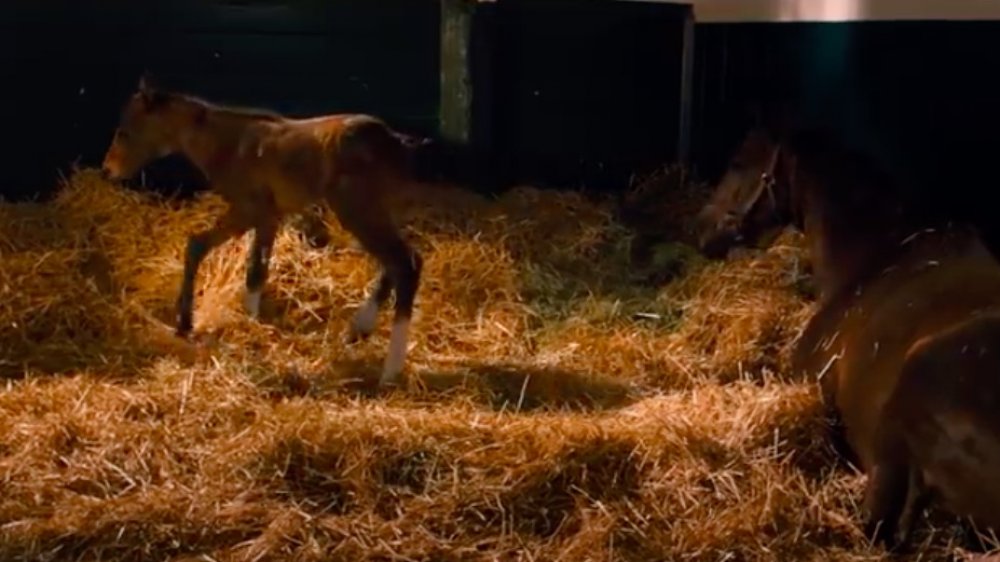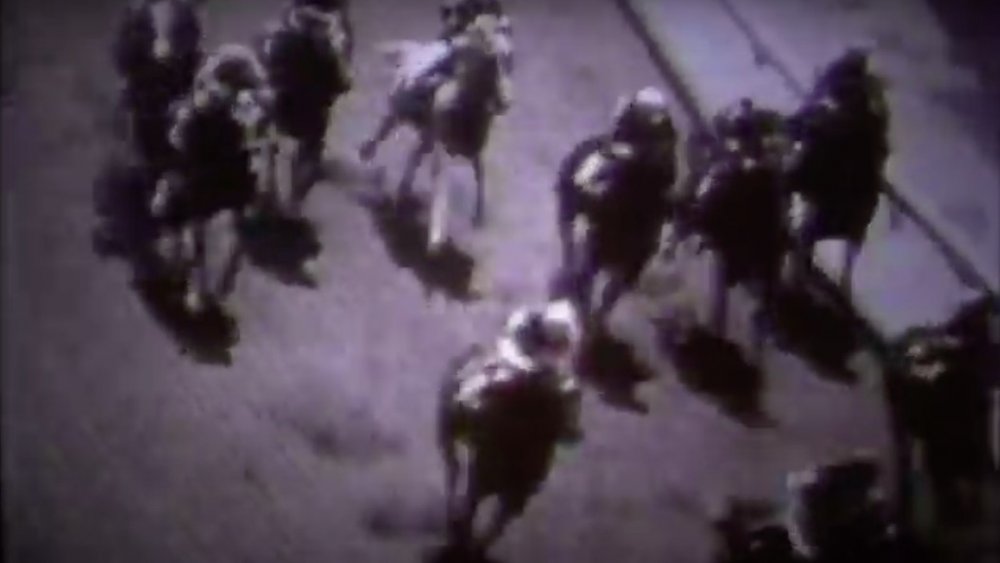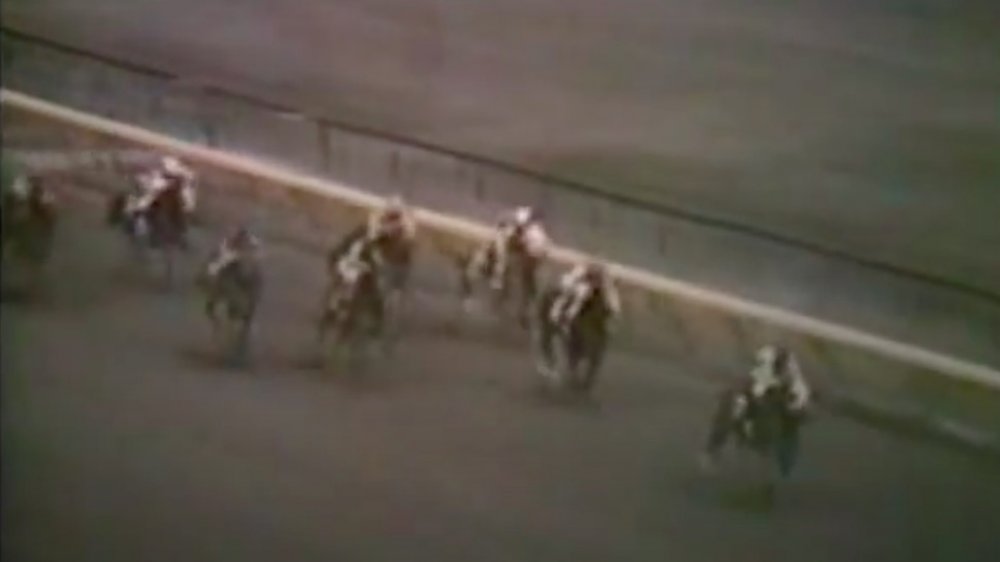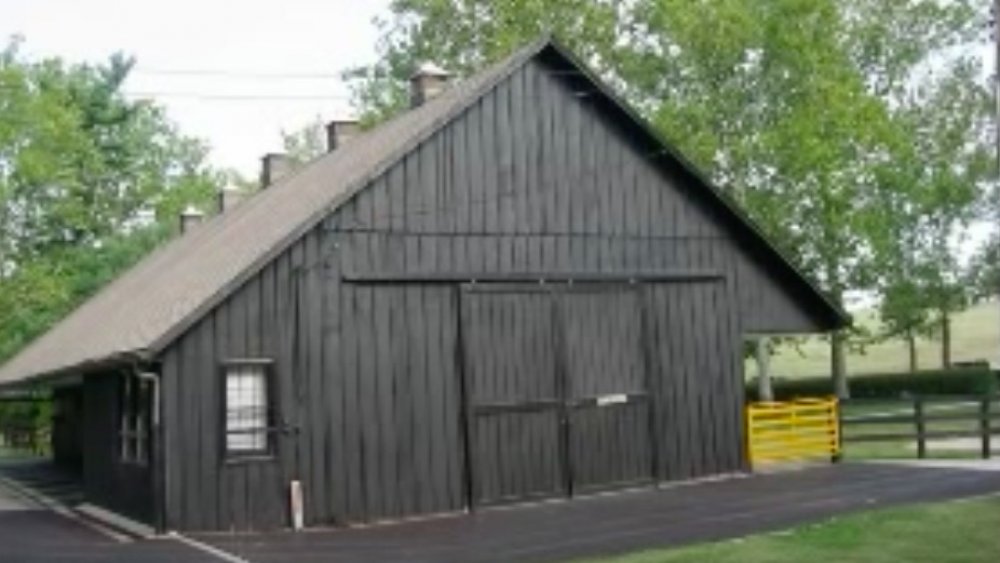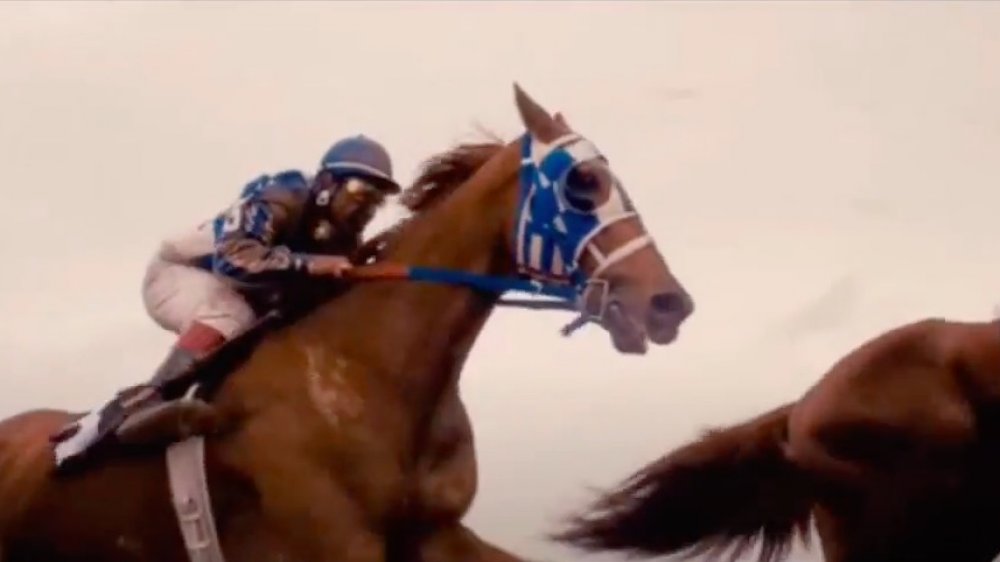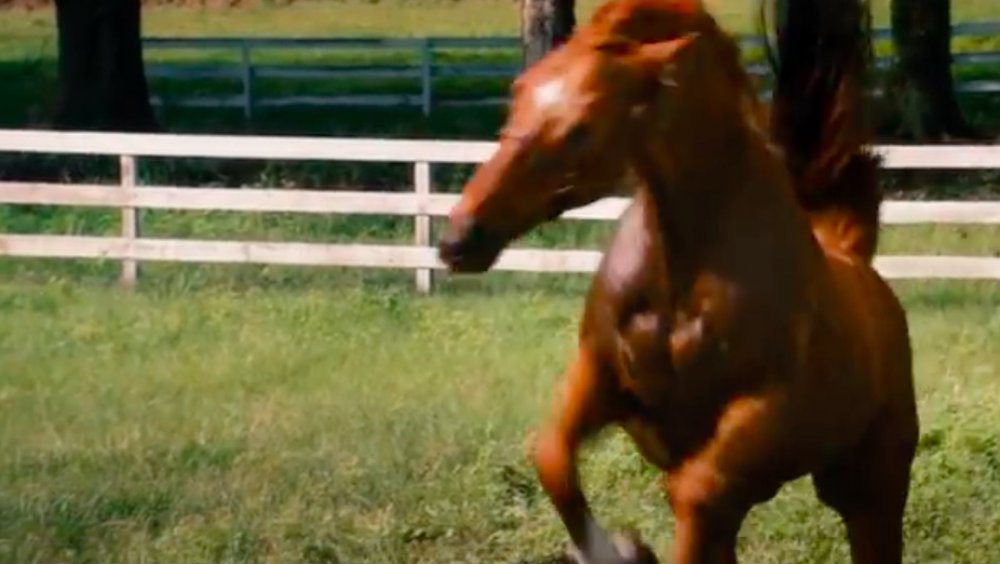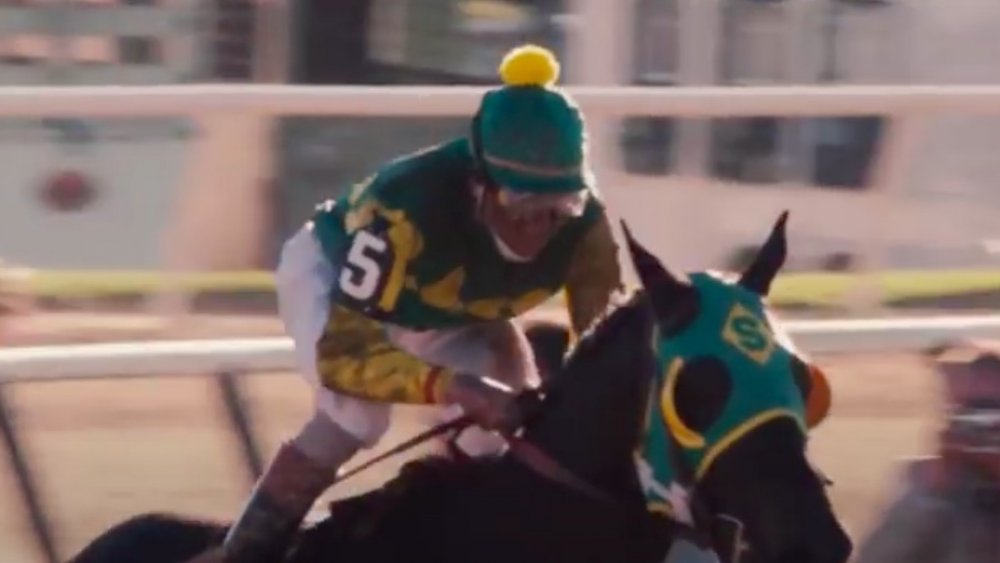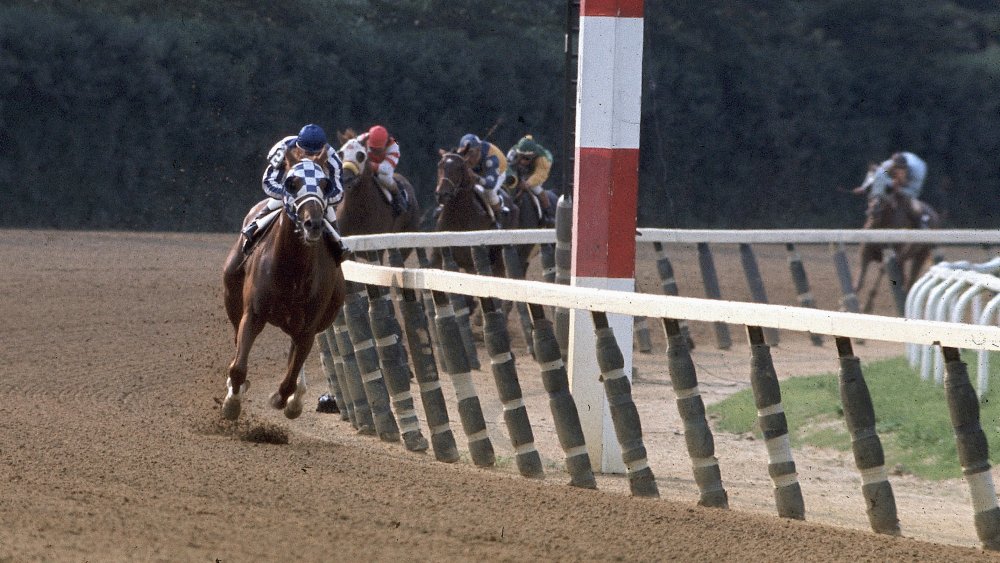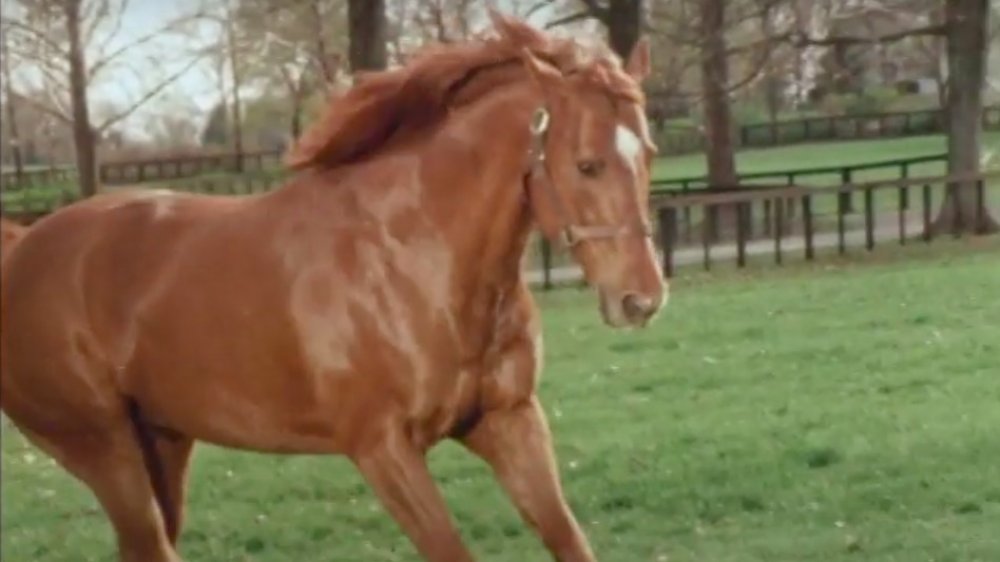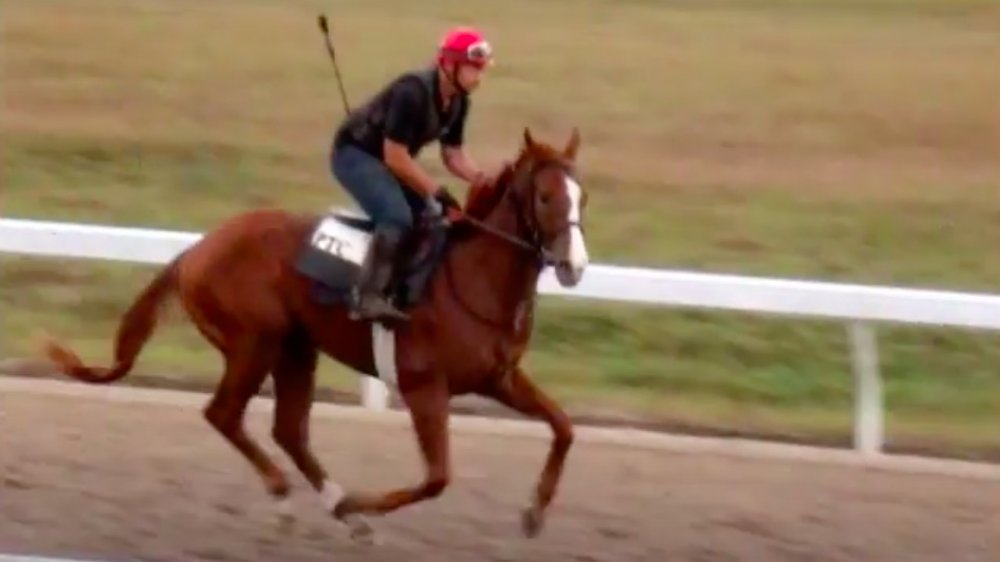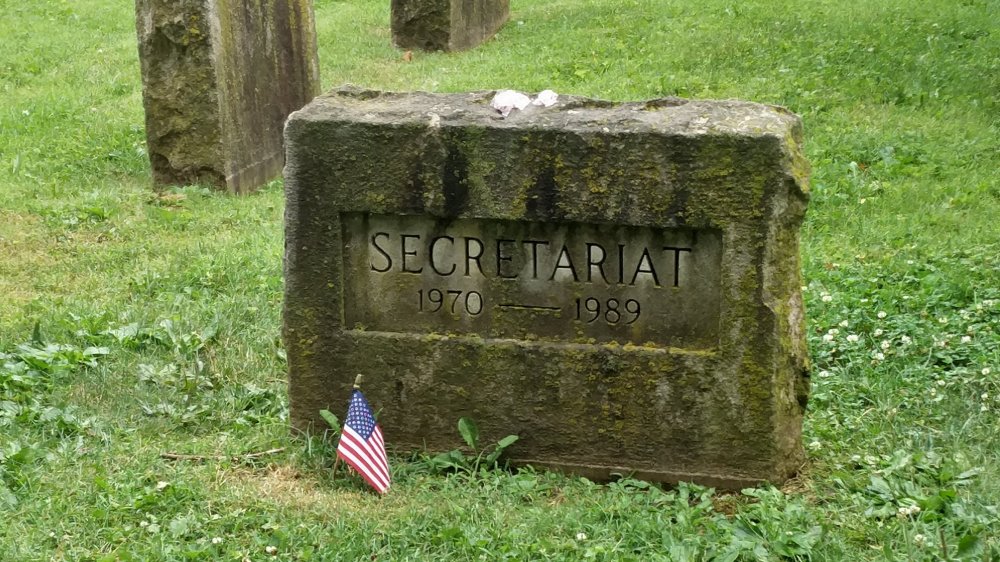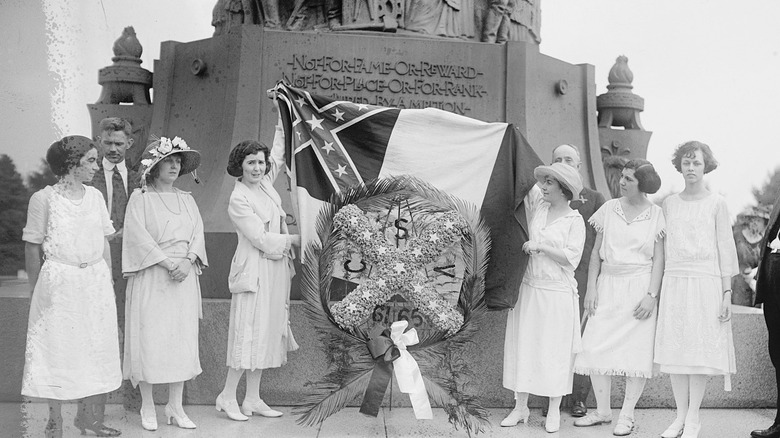
The Crazy Real-Life Story Of Secretariat
You don’t have to be a horse racing fan to appreciate Secretariat’s jaw-dropping win at the Belmont Stakes in 1973. No horse ever won like that before, and no horse has ever won like that since. As the camera pans out to show the field opening up behind him, it can’t go wide enough to show any of the horses he left far behind in his incredible 31-length victory. That moment is still widely regarded as one of the greatest performances in sports history — human, horse, or otherwise.
In the decades since “Big Red” won the Triple crown, a lot of horses have tried to match his performance. A few followed in his footsteps and became Triple Crown winners, but none of them did it as spectacularly as Secretariat did. His secret? He had a big heart. Literally. Here’s everything you need to know about the big, red champion’s remarkable life.
When Secretariat was a foal, no one really thought much of him
Racing stables don’t really make scrapbooks for baby horses, so there isn’t much in the history books about Secretariat’s early life. We do know that he was born at 12:10 AM on March 30, 1970, and it’s probably safe to say that he was cute, had long legs, and did a lot of frolicking.
We also know that Secretariat didn’t really impress any of the humans who interacted with him, at least not at first. According to History, stud manager Howard Gentry called him a “big, strong-made foal with plenty of bone.” That’s an okay compliment, if you’re a horse, but it’s not much more than okay. Eddie Sweat, who would later become Secretariat’s groom, was similarly underwhelmed. “I didn’t think much of him when we first got him,” he told Canadian Horseman in 1973. “I thought he was just a big clown. He was real clumsy and a bit on the wild side, you know. And I remember saying to myself I didn’t think he was going to be an outstanding horse.”
Secretariat's owner was also a record holder
Secretariat was a remarkable horse, but he also had a remarkable owner. According to USA Today, Penny Chenery took over her father’s failing thoroughbred stables when his health began to decline in the late 1960s. In 1969, she decided to breed one of her father’s horses to the thoroughbred stud Bold Ruler, and Secretariat was the second foal born from that pairing.
Toward the end of her father’s life, Chenery helped him fulfill his dream of owning a Kentucky Derby winner. That horse wasn’t Secretariat, though. It was Riva Ridge. Secretariat started winning races the following year, after Chenery’s father’s death.
Chenery went on to achieve a number of firsts in the horse racing world. She was one of the first women admitted to the Jockey Club, and she was the first woman to serve as president of the Thoroughbred Owners and Breeders Association. In 2006, she received an Eclipse Award of Merit for lifetime contributions to the thoroughbred industry. She died in 2017 at the age of 97.
The name “Secretariat” wasn't their first choice
If you’ve ever wondered why racehorses have such odd names, well, it’s partly because you can’t use a name that’s already been taken. Claiborne Farm had a long list of names they wanted for their horse, including “Scepter,” “Royal Line,” “Something Special,” and “Games of Chance.” The name “Secretariat” was actually their sixth choice after “Deo Volente,” and it was suggested by Elizabeth Ham, who was — wait for it — Penny Chenery’s secretary.
According to Mental Floss, though, Ham actually chose the name because she’d once worked at the United Nations in Geneva, and that’s the seat of the old League of Nations (pictured) secretariat. A secretariat, by the way, is the permanent administrative department of a government organization. Riiiiight. Like we’re supposed to believe you named the horse “Secretariat” after some boring administrative office and not because you were, you know, his owner’s secretary.
Secretariat didn't win every race he ever ran
Even the best athletes have off days, and horses aren’t any exception. Secretariat may have been the greatest racehorse of all time, but he didn’t win every single race he ever ran.
According to History, Secretariat finished fourth during his first race, but that probably had something to do with getting bumped at the start, which could have thrown him off his game. Even so, he managed to pass six horses to land in fourth place in the home stretch. Leading up to his legendary Triple Crown win, Secretariat finished first in the Champagne Stakes but was disqualified to second because he’d bumped the second-place horse in the final 3/16ths of the race. He also finished third in the Wood Memorial, just prior to the Kentucky Derby, and he finished second in two of his post-Triple Crown races — the Whitney Stakes and the Woodward Stakes.
Even so, Secretariat was “in the money” in all but one of his races, which means he never finished at the back of the pack. As far as “off days” go, those are still pretty good ones.
Secretariat's performance at the Hopeful Stakes was pretty astonishing
By the time Secretariat left the gate at the Hopeful Stakes in August 1972, everyone knew he was a great horse. But during that one minute, 16.2 seconds, there were some not-so-subtle hints as to just how great a horse he actually was.
According to Sports Illustrated, Secretariat was the last horse out of the gate, and by the time the pack got to the far turn, he was still in ninth place. Then he swung to the outside. Just after the half-mile mark, Secretariat started to pick up speed, and he finished the race six lengths ahead of the second-place winner. His time was stunning — he’d covered the last quarter of the race in 22 seconds, accelerating from last place to first place in 290 yards.
This would have been amazing for any horse, but keep in mind that this was during Secretariat’s two-year-old season. “I’ve never seen a 2-year-old do that,” said one racetracker and handicapper who watched the race. “He looked like a 4-year-old out there.”
Secretariat was syndicated for $6.08 million
Secretariat showed great promise, but promise alone wasn’t enough to solve Penny Chenery’s financial woes. After her father’s death, Claiborne Farm was faced with an enormous tax problem, and Chenery had to come up with a way to pay the bill.
In the February before the Kentucky Derby — the first leg in the road to the Triple Crown — Claiborne Farm syndicated Secretariat as a breeding stallion for a record $6.08 million. In case syndication is not a concept you’re familiar with, that means if you wanted a piece of Secretariat, you could buy shares in him just like you can buy shares in Microsoft or Tesla. There wasn’t as much of Secretariat to go around as there is of a tech stock, though — 32 shares of the stallion went for $190,000 each. Just to put that into perspective, Sports Illustrated says gold was selling for $90 an ounce in 1973, and Secretariat weighed 1,154 lbs, which made him worth about three times his weight in gold.
Secretariat got the poop kicked out of him at the Wood Memorial
Coming into the Wood Memorial in April 1973, Secretariat was riding high. Or, his jockey was riding high on him, or something. Anyway, a lot of people viewed the colt as unstoppable at that point.
The Wood Memorial is a Kentucky Derby prep race. At nine furlongs, or a bit over a mile, it is a test of a horse’s stamina and still a furlong shorter than the Derby. Secretariat ran the race unenthusiastically and finished third, leaving many people to speculate that he might be a speed horse rather than a distance horse. According to Sports Illustrated, no son of Secretariat’s sire, Bold Ruler, had ever gone on to win any of the three Triple Crown races. He’d produced fast horses, but none of his progeny had the stamina it took to win those longer races.
Secretariat’s trainer later blamed his poor performance on an abscess inside the horse’s mouth, which sounds plausible in retrospect, since Secretariat very obviously did go on to prove that he had the stamina to win not one but all three Triple Crown races.
Secretariat had a sense of humor
If you’re not a horse person, you probably mostly think of horses as hay-eating, pooping machines. And they kind of are, but they also have personalities. Some of them can be quite serious. Some of them can be obnoxious. Secretariat was all business on the track, but off the track, he was a clown.
How exactly does a horse become a clown? Well, according to HuffPost, Secretariat’s groom said he’d sometimes grab a bottle of beer with his mouth if there happened to be someone partaking nearby. A reporter who followed Secretariat’s career claimed that the horse once snatched his notebook. Another time, Secretariat picked up a rake in his teeth and used it to rake his own stall. No, really. Witnesses say he pushed and pulled the rake across the floor of the stall, much like his groom did every day.
The people who knew him also say he got depressed when he lost a race and would stand in the corner of his stall and avoid any humans who came to see him. His jockey, Ron Turcotte, said the horse would stop and pose whenever he heard the sound of a camera. Sure, that’s all a little anthropomorphic, but can you really blame any of those people lucky enough to know him? “He was a little proud of himself,” Turcotte once said. “He carried his head high […] he knew he was something special.”
The Kentucky Derby was more than just a comeback
After his poor performance at the Wood Memorial, Secretariat had more than a few doubters. Going into the Kentucky Derby, Secretariat’s odds were 3-2, the same as Angle Light, the horse that beat him in the Wood Memorial. So people still thought he might win, but they also thought Angle Light might win.
According to Secretariat.com, Secretariat left the gate near the back of the pack and cruised along in 11th place for a bit. Then he started passing horses. By the time he reached the far turn, he was in fifth place, and he gradually passed the next three horses, too, until he was head-to-head with the pack leader. The two shadowed each other for about 100 yards, and then Secretariat gradually pulled away, winning by two and a half lengths.
There were a few really remarkable things about that race. First, Secretariat set a track record that still stands today: 1 minute, 59.4 seconds. Second, Secretariat had accelerated through the entire race, which is the opposite of how most racehorses do things. Most racehorses start strong and slow gradually — even when they appear to be accelerating at the end of a race, they are really going slower than they did out of the gate because at that point, all the horses are tired. So Secretariat not only won the Kentucky Derby, but he did it totally backwards.
Secretariat's performance at the Belmont Stakes was epic
If you’ve never seen Secretariat at the Belmont Stakes, well, you have to see it. The Belmont is one of the most grueling races there is — it’s a mile and a half long, and it’s pretty hard on the heels of the Preakness, a race that’s almost as grueling, which is hard on the heels of the Kentucky Derby, which is also pretty grueling. So no one really expects to be blown away by the winning horse. Impressed, maybe, but probably not blown away.
Secretariat wasn’t an ordinary winner, though. According to Sports Illustrated, the horse took the first-place position after the first turn, and then his lead just kept getting bigger. By the half-mile mark, he was ahead by seven lengths. Halfway around the turn, he’d doubled his lead to 14 lengths. As he turned for home, he was ahead by 20. When he crossed the finish line, the other horses were so far behind that the camera couldn’t pan wide enough to include them all in the frame. He won the contest by an astonishing 31 lengths. It was not only the fastest Belmont victory in history, but it was also the fastest mile-and-a-half run by any horse anywhere in the United States, ever.
Secretariat’s Belmont victory, the Kentucky Derby, and the Preakness (which he’d won by two and a half lengths less than a month earlier) made Secretariat the first Triple Crown winner in 25 years.
Secretariat retired at the tender age of three
Racehorses have grueling careers, but they tend to be short – it’s not uncommon for a racehorse to retire at four, and Secretariat’s career ended in November of his third year. A lot of horses retire because of an injury, but Secretariat went out on a high note after his six-and-a-half-length victory at the Canadian International. Why did he retire? Claiborne Farms needed his stud career to begin early, because money.
They weren’t going to let him go without a proper farewell, though. On November 6, 1973, Secretariat arrived at the Aqueduct racetrack in New York, where he won his first race in July 1972. But he wasn’t there to run — he was there for a party. He even had the whole day named after him: “Farewell to Secretariat Day.”
According to Secretariat’s Meadow Blog, though, Secretariat was the only one there who didn’t feel like celebrating. His jockey jogged him to the quarter pole and back so that everyone could get a good look at him, but that kind of just pissed the big horse off. In fact, Secretariat’s trainer later said he was so mad he wasn’t there to race that he ate Penny Chenery’s bouquet while posing for photos in the winner’s circle.
Secretariat's stud career was kind of unremarkable
Racing stables don’t just need horses who can run — they also need horses that can produce offspring that can run. Ultimately, that’s what keeps the lights on. So when Secretariat went out to stud, everyone had really high hopes for him, and they were also pretty understandably freaked out about it all.
Just as a precaution, the first mare they bred Secretariat to wasn’t one with wealthy owners eager to own the son or daughter of a racing legend — it was an Appaloosa nurse mare named Leola who lived at Claiborne farms. According to This is Horseracing, Chenery wanted to make sure that Secretariat could … err … successfully do the deed, so they tried him out on a local girl first. Leola’s son (whose name was First Secretary, duh) went on to become an Appaloosa sire with a number of grand champions and successful Appaloosa racehorses among his progeny.
But for the most part, Secretariat’s stud career was a disappointment. None of his sons went on to become leading sires, although, per Sporting Post, many of his daughters did go on to produce winners of the Preakness, Belmont, and other important races.
Secretariat lived fast and died young … literally
With good care, horses can live more than 30 years, and Secretariat had the best care. But he still died relatively young, at the age of 19, after a tragic bout with a debilitating disease called laminitis. Horses with laminitis have inflammation in the structures inside the foot that secure the bone to the hoof. If it’s bad enough, the bone might separate from the hoof wall, and the bone can actually sink down and penetrate the bottom of the horse’s hoof. It’s a painful condition, and horses suffering from bad cases of it often have to be euthanized.
Secretariat developed laminitis on Labor Day of 1989. According to Sports Illustrated, he fought the illness for a month and seemed to be improving, but then he took an unexpected turn for the worse. He was in so much pain that Claiborne Farms had to make the heartbreaking decision to end his life.
The big horse had one final surprise for everyone, though: The veterinarian who performed his necropsy discovered that Secretariat had a heart that was almost twice as big as a normal horse. “It wasn’t pathologically enlarged,” he later said. “All the chambers and the valves were normal. It was just larger. I think it told us why he was able to do what he did.”
Secretariat ranks higher than many great human athletes
When most people think of the greatest athletes of all time, they think of Michael Jordan, Babe Ruth, and Muhammad Ali. And yeah, those guys did make ESPN’s list of the top 100 greatest North American athletes of the 20th Century (from one to three, in that order). But that list also contained three non-humans: Secretariat and fellow racing legends Man O’ War and Citation. But while Man O’ War and Citation were 84th and 97th, respectively, Secretariat was pretty high up on the list in 35th place, just between Lou Gehrig and Oscar Robertson.
In 2005, Secretariat was honored by ESPN a second time: This time, he appeared on the ESPN Classic show Who’s No. 1?, which featured a list of the greatest sports performances by individual athletes. Secretariat was the only non-human to make the list, and his Belmont win ranked second, just behind Wilt Chamberlain’s 100-point game.

Whatever Happened To Usain Bolt?

What The Cleveland Baseball Team's New Name Really Means

Olympians Who Landed Gigs In Hollywood

The Tragic Real-Life Story Of Simone Biles
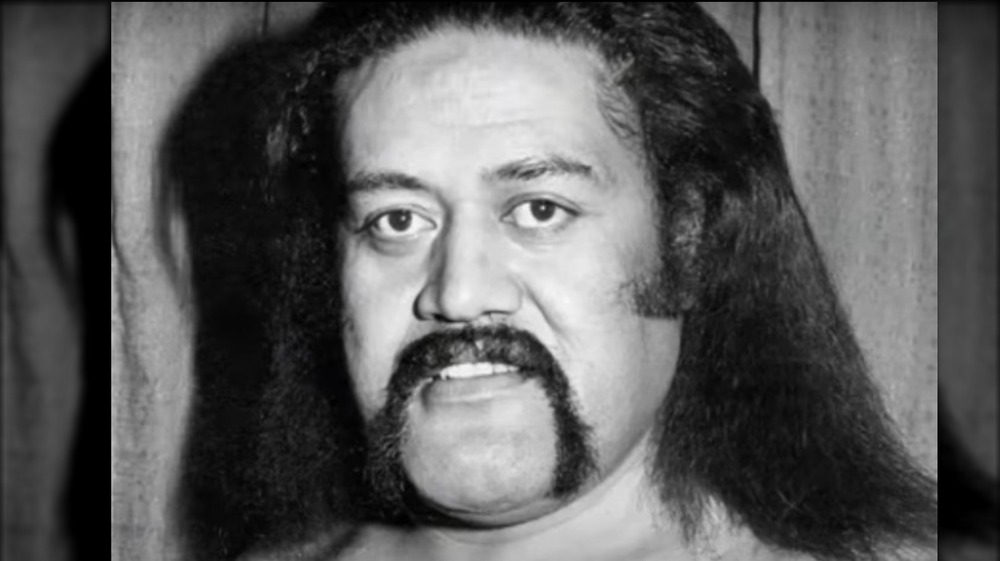
Here's How Much Wrestler Afa Anoa'i Is Worth Today
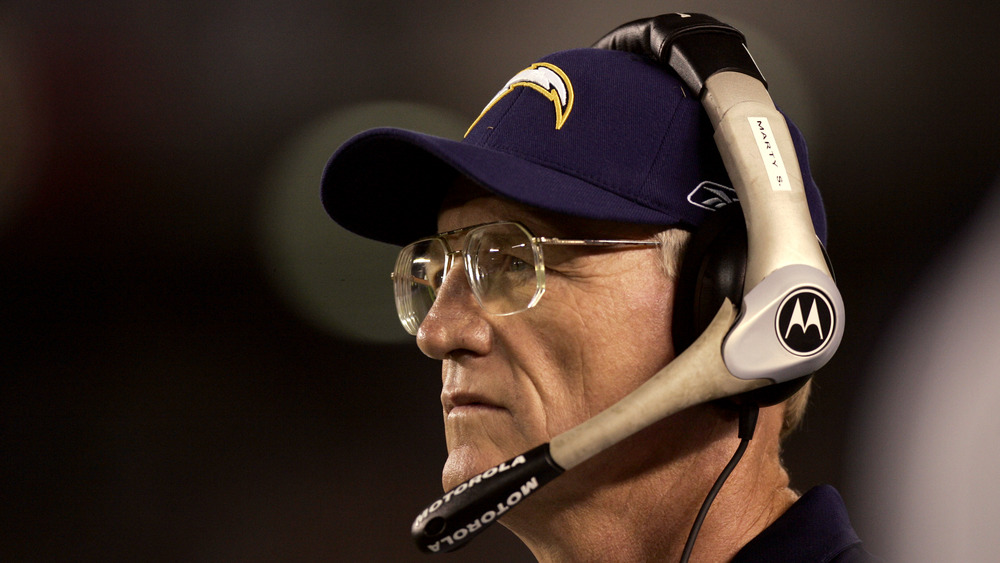
What Was NFL Coach Marty Schottenheimer's Net Worth When He Died?

These Are The Most Common Injuries For NFL Players

Every Athlete That's A Billionaire Today

What These WWE Divas Are Up To Today

The Untold Truth Of Kobe Bryant
